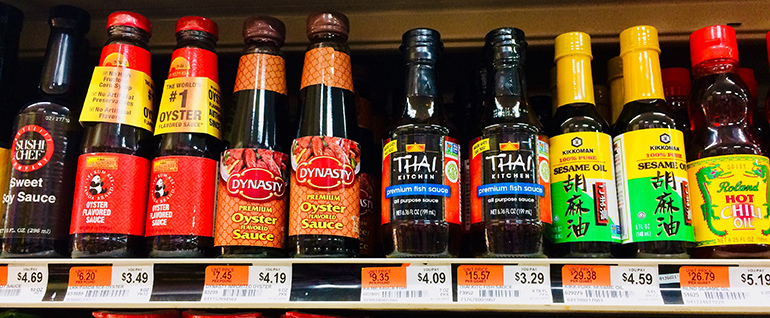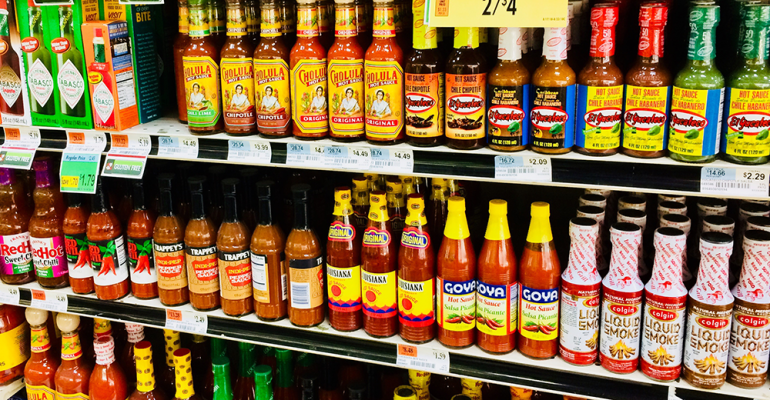It was five years ago when the headlines hit the public: “Salsa overtakes ketchup in U.S.,” blared the Drudge Report in all caps, while Business Insider announced, “Salsa is America’s favorite condiment.” It became a story that, in the parlance of the day, “broke the internet.”
All of the coverage referenced an Associated Press article that got tremendous play in October 2013, predicting that “salsa overtaking ketchup as America’s No. 1 condiment was just the start.” Taking a look at the condiment market today certainly bears out the prediction that a shakeup was occurring — and far beyond just salsa.
Today’s condiment category ranges from traditional staples like mustard and ketchup (still very much in the game), salad dressings and mayonnaise to more innovative flavor options like salsa and Sriracha, soy sauce, varieties of hot sauce, healthful and organic products, vegan and on and on.

The table and cooking sauces segment dominates the sauces, dressings and condiments market in the U.S. because of the high demand for products exhibiting international and spicy qualities, according to market research firm Technavio in its report, “Sauces, Dressings, and Condiments Market in the US 2017-2021.” The growth of these products can be attributed to the increasing consumption of international and regional sauces, dressings and condiments compared with regular American table sauces, such as mustard, ketchup and mayonnaise, by the diverse population, which includes Asians and Hispanics.
According to Akash Pandey, a lead food research analyst from Technavio, “One of the few changes in table sauces segment is the sudden rise in the demand for hot sauces, including Tabasco, Sriracha, chipotle sauce, habanero sauce and hot salsa sauce. The influx of multicultural groups in the U.S. is a major factor that influences the adoption of these sauces. Changing culinary trends drive the market growth.”
Beyond flavor: Better-for-you
Consumer demand for these products and the flavors they impart helped the market for condiments and sauces reach $24 billion in 2016, according to data from Packaged Facts. Market growth in 2016 marked an annual rate of more than 2% over the preceding five years. Comparable — if not slightly lower — sales growth is anticipated year-over-year through 2021 despite challenges to the industry due to the widespread shift toward healthier living. In fact, that move to better-for-you may provide an opportunity in the condiment market.
“The trend toward healthy eating has created challenges for marketers of sauces and condiments, as the perception that sauces and condiments are an unnecessary and unhealthy addition to many foods has made some consumers cut back on consumption,” said David Sprinkle, research director, Packaged Facts. “As a result, sauces and condiments are increasingly marketed as organic and healthy, with new options such as low-sodium or low-sugar varieties supporting restrictive diets.”
 Marketing products as certified organic or carrying “free-from” labels has become part of several trends that will help keep sauces and condiments popular with a range of influential consumers, said Sprinkle, including Baby Boomers, Millennials, Hispanics and African Americans.
Marketing products as certified organic or carrying “free-from” labels has become part of several trends that will help keep sauces and condiments popular with a range of influential consumers, said Sprinkle, including Baby Boomers, Millennials, Hispanics and African Americans.
“Consumers are looking for healthier options not only with the foods they are eating but with what they are topping those healthier choices with,” agreed Michelle Mendoza, director of marketing at Associated Supermarket Group in New York, whose banners include Associated and City Fresh. “Highly sweetened sauces are on a decline, while more savory options are on a rise. You are also seeing consumers asking for more yogurt, chili, olive oil and vinegar-based condiments to keep food toppings lighter.”
That’s not to say that there’s no room for the old favorites, Mendoza noted. “Barbecue sauce and ketchup are still our top condiments,” she said. “National favorites Heinz and Hunt’s perform very well.”
Flavor flux
City Fresh knows firsthand about the impact of changing demographics on store selection and store categories like condiments that are sensitive to that. Earlier this year it opened its latest store in the heart of Spanish Harlem, Manhattan’s most recent neighborhood undergoing rapid growth and development.
“City Fresh’s management knew it needed to provide the condiments and flavoring for its diverse consumer preferences,” said Mendoza. “Condiments are at the core of what make mainstream and traditional foods authentic. Based on consumers’ country of origin, requests for imported condiments will rise.”
Miveri Colon, operations lead for City Fresh, added that “with a recent Mexican population growth in Spanish Harlem, we are seeing a demand for Mexican hot sauces. Cholula, Tapatillo, and La Morena are our best-sellers.”
The search for diverse condiments may go beyond the traditional grocery items, said Mendoza. “In the U.S., we have been conditioned to believe condiments are found only in the grocery aisles. As more consumers are familiar with international cuisines through travel or through the array of international restaurants here, there are requests for fresh chili peppers (various types), agave and Asian products like peanut and oyster sauces. Even dairy products like sour cream and yogurt are starting to have a seat at the condiment table.”
Overall, she said, “Spicy is in, but more of a Latin or Asian spice than a Cajun or Southern type of spicy.”
“It is extremely important to satisfy fast-changing consumer taste and eating habits,” she noted. “Our grocery department offers hard-to-find condiments and hot sauces along with other ethnic products from various Latin and Asian countries.”
Trends to watch in specialty condiments
According to the New York-based Specialty Food Association (SFA), specialty condiments — which include international, innovative and unique, new flavors — account for about 20% of all condiment sales. The category grew by 16% since 2013 and is expected to grow another 19% by 2022.
“Some of the innovations we’re seeing in condiments are plant-based spreads,” said Denise Purcell, director of content at SFA. “ Also, less sweet cooking sauces and diverse ethnic offerings. Consumers are gravitating toward authentic ethnic condiments like harissa, for example.”

Refrigerated is trending in condiments: Consumers equate that with fresh and that is what they are seeking. Specialty refrigerated condiments grew almost 17% between 2015 and 2017. They were also up 19 percent in unit sales versus specialty shelf-stable condiments, which increased 2%.
Cooking sauces, mayo (including a variety of bold new flavors) and hot sauce contribute most to sales — cooking sauces account for 40% of total specialty condiment sales, according to SFA. “They attract consumers seeking kitchen shortcuts,” said Purcell. “Condiments in general tend to be a gateway category for specialty food newbies.”
In addition, Purcell noted, “Younger consumers, especially Millennials, have an affinity for convenient meal options like fresh entrées, which impacts home cooking. However, they can also be using condiments to dress up entrées or prepared foods or takeout. Even younger consumers, the iGeneration, which is 18 to 23 years old right now, are most likely to say they use specialty foods for snacking, which bodes well for subcategories like salsa.”
EXPRESS LANE
 Yogurt as condiment
Yogurt as condiment
Chobani Savor’s 14-ounce squeezable packages are intended to position Greek yogurt as a condiment or topping, like sour cream. It’s available in both low-fat (2% milk fat) and whole-milk (5% milk fat) varieties.
chobani.com
Mayo + Ketchup
Heinz Mayochup, the blend of Heinz Ketchup and Heinz Mayonnaise, is rolling out in the United States this year to great media attention. Currently the company is running a social media campaign asking the public what the new product should be called — or if it should just stay Mayochup.
heinz.com/products/HeinzMayochup






